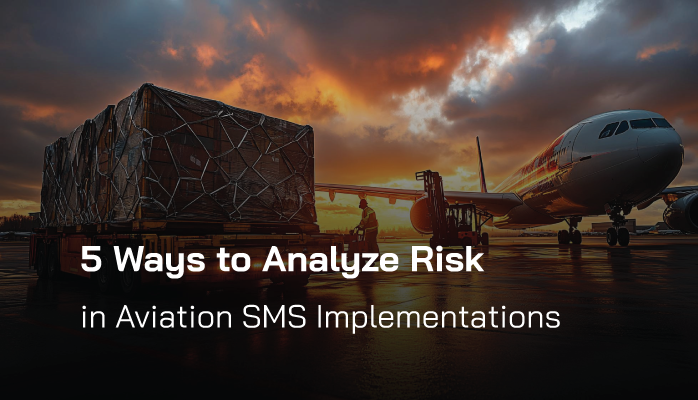What Is Risk in Aviation SMS Implementations

Risk in aviation safety management systems (SMS) is a tricky subject. Not only is it treated differently in different organizations, but safety professionals tend to get up in arms in front of differing opinions.
The truth is that “risk” is a terribly nebulous word and concept, with multiple ways to use it. What’s important is NOT that you “know what risk is” so much as you “define what risk means to your organization.”
Here are multiple ways that “risk” is used in the risk management industry, in descending order of common use:
- The likelihood and severity of safety mishap occurring;
- Negative safety outcomes, such as damages to equipment or aircraft, injuries, deaths, etc.; and
- Loss of safety control (i.e., “dangerous condition” or “risk event”).
Related Aviation Safety Risk Management Articles
- Difference Between Reactive, Predictive and Proactive Risk Management in Aviation SMS
- How to Identify Hazards and Assess Risks in Aviation SMS - With Free Resources
- What Is the Process of Risk Management in Aviation SMS
What Is Risk Analysis in Aviation SMS
Risk analysis is an activity whereby safety management personnel attempt to quantify or qualify a risk. Generally, this quantification/qualification is an assessment used to identify:
- Operational hazards;
- Amount of exposure;
- Quality of current risk controls; and
- Needed risk controls.
All of these elements factor into what risk is. The one common factor in nearly all risk management activities is the use of the risk matrix, as it's the most efficient tool to document severity and probability. Below we discuss 5 ways to analyze risk in aviation SMS implementations.
1. Historical Analysis (Reactive Risk Management)

Historical Analysis is a risk analysis activity used to analyze safety incidents that have already occurred. It is probably the most common of all ways to analyze risk in aviation SMS implementations. Some example activities of historical analysis are:
- Risk management processes performed on similar types of identified safety concerns;
- Review of past investigations;
- Reviewing or validating previously closed safety concerns to ensure mitigation strategies remain effective;
- System policy review (i.e., have policies/procedures been classified with reported safety issues during the risk management process?);
- Trend analysis; and
- Data analysis and data mining.
Some sources online will say that historical analysis is useful for predictive analysis, however, this is a dangerous assumption because “Past successes are not future guarantees.” The primary goal of historical analysis is to understand:
- Where the safety management system is performing well or under-performing;
- Where the SMS implementation does not maintain an Acceptable Level of Safety; and
- Which hazards need additional risk controls?
Historical analysis is probably the most common way to analyze risk and should be the first type of risk analysis activity that your documented risk management processes promote in your SMS manual.
Related Aviation SMS Manual Articles
- How to Create Your Aviation SMS Manual
- Tips Writing SMS Manuals With Aviation Safety Database Solutions
- Best Practices: Reviewing Aviation SMS Manuals
2. Exposure Analysis (Proactive Risk Management)
Exposure analysis is a risk analysis activity with the goal of proactively identifying exposure to resources located in identified hazardous areas. It is one of the best ways to analyze risk in SMS implementations and evaluate exposed resources. These resources can be:
- Human;
- Equipment;
- Aircraft; and
- Other assets.
Exposure analysis will uncover how these resources are vulnerable in the given “system.” The system is the collection of:
- Risk control measures;
- Safety policy;
- Safety procedures;
- Existing Norms (Human Factors);
- Organizational interfaces (internal and external);
- Facilities and other structures; and
- Other infrastructure.
Exposure analysis is proactive risk management because it actively seeks out areas of the SMS program that can be improved before safety mishaps occur because of the inadequacies. Risk analysis activities that fulfill Exposure Analysis are:
- Leading indicator development;
- Safety policy review;
- Emergency Drills;
- Safety procedure analysis;
- Safety inspections; and
- Internal Safety audits.
All of these activities are designed to seek out exposure before accidents occur.
Related Proactive Risk Management Articles
- 20 Questions for Your Safety Risk Management Process in Aviation SMS [With Free Checklists]
- From Reactive to Proactive Hazard Identification in Aviation SMS
- 7 Great Incentives for Proactive Risk Management in Aviation SMS
3. Scenario Analysis (Predictive Risk Management)

Scenario analysis is a predictive risk management activity. It is used when safety management needs to consider how the aviation SMS will perform in hypothetical situations (that have not occurred yet).
The two most common uses for this are for:
- Management of Change; and
- Safety Cases.
Scenario Analysis can be used with many common risk analysis tools, so long as the analysis is being performed on a hypothetical scenario:
- Bowtie analysis;
- Investigations; and
- Risk assessments.
Goals of Scenario Analysis is to “stress test” the SMS implementation to see how it handles novel situations.
Related Predictive Risk Management Articles
- How to Practice Reactive, Proactive, and Predictive Risk Management in Aviation SMS
- Going From Reactive to Predictive Risk Management in Aviation SMS
- How Aviation Safety Managers Reach Predictive Analysis Phase
4. SMS Shortfall Analysis (Qualitative Risk Analysis)
SMS Shortfall Analysis is a qualitative risk analysis tool for answering one question: where did the SMS implementation fail? This is different from reactive risk management in that:
- Reactive risk management is designed to understand how and why safety incidents occur; but
- These tools don’t actively identify how the SMS program failed.
SMS Shortfall Analysis is designed to clarify two different things. First, where did the SMS' risk management efforts fail in terms of:
- Risk control measures;
- Human action; and
- Safety policies and procedures.
Second, was the failure the result of:
- SMS bureaucracy; or
- Safety culture.
The outcome of performing this analysis is a chart that visually identifies the extent and makeup of the failure, as well as a table that specifically identifies the different failures.
It is called SMS Shortfall Analysis because it is a discovery tool for understanding the shortcomings (i.e., shortfalls) of your SMS' risk management processes in safety incidents.
5. Event Trees (Quantitative Analysis)
Event trees are simple quantitative risk analysis tools that establish probabilities for various risks occurring after a hazard – hence, “quantitative.” Event trees involve establishing:
- A hazard (dangerous condition);
- A list of all various outcomes; and
- The interceding events between the hazard and each outcome.
Depending on how many interceding events can lead to certain outcomes, you can establish which outcomes are most likely in terms of probability.
Related Articles on Risk Analysis in Aviation SMS
- What Is Process for Risk Analysis in Aviation SMS
- How to Perform Risk Analysis in Aviation SMS
- How to Organize Data for Good Data Analysis in Aviation SMS [Best Practices]
Final Thoughts on Risk Analysis Strategies in Aviation SMS Implementations
As we have seen, there are various strategies to analyze risk in aviation SMS implementations. Furthermore, there are preferred times to use each strategy in the aviation risk management life-cycle, whether you are in the:
- Reactive phase;
- Proactive phase; or
- Predictive phase.
This was not an exhaustive treatment of risk analysis strategies. You may have other preferred tools that are either independent stand-alone tools or an integrated suite of tools that are embedded within your aviation SMS database application. Integrated risk management tools are vastly superior to stand-alone tools because the integrated tools can deliver results in real time and can be easily embedded within the aviation SMS database's risk management workflows.
An aviation SMS database offers more advantages than simply having robust data analytical tools. The aviation SMS database provides your company with repeatable risk management processes that can be easily tracked throughout the entire risk management process.
To learn how your company can benefit from an SMS database that has many risk analysis tools, please watch these short demo videos.
Last updated in December 2025.







